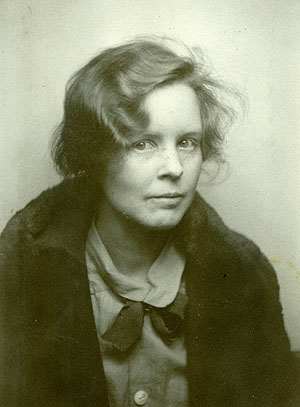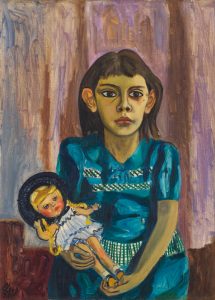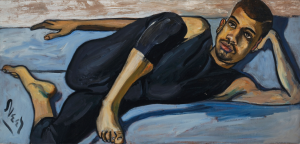 Born January 28, 1900, the painter Alice Neel grew up right along the twentieth century, though she was less a product of her time than a harbinger of times to come. Significant success eluded her until the sixties; a true Aquarian, she was built for that decade of upheaval–and this new century of upheaval, too. Today, her hard gems of truth and beauty illuminate what we most need to see.
Born January 28, 1900, the painter Alice Neel grew up right along the twentieth century, though she was less a product of her time than a harbinger of times to come. Significant success eluded her until the sixties; a true Aquarian, she was built for that decade of upheaval–and this new century of upheaval, too. Today, her hard gems of truth and beauty illuminate what we most need to see.
Neel first came on my radar as I was rushing through a gallery of contemporary paintings at the Brooklyn Museum of Art, were I screeched to a full stop in front of her 1974 portrait of former museum department head John I. H. Baur. With a palette of slate and ochre and a bold, almost slapdash brushstroke, she’d conveyed him as an institutional hack and a bemused enabler. It was rueful and rich, and though I hurried on, when I saw the Zwirner gallery was hosting a show of her work, I hurried right there as well.
These paintings of her family, neighbors, friends, lovers, and political comrades in Spanish Harlem and the Upper West Side are not perfect. In some cases, they could ask more, tell more.  But they resonate as few twentieth-century portraits do because they are so vibrant and cock-sure – so defiantly gripping.
But they resonate as few twentieth-century portraits do because they are so vibrant and cock-sure – so defiantly gripping.
Hilton Als reviews theater, not fine arts, for The New Yorker. Yet he curated this Zwirner exhibition, perhaps because Neel’s intensely democratic curiosity mirrors his own. (His Neel book will be released this June.) In a catalog essay, he shares what this child of West Indian immigrants, raised in deep Brooklyn to become a Pulitzer Prize-winning journalist, initially recognized in her work:
The pictures were a collaboration, a pouring in of energy from both sides – the sitter’s and the artist’s. This was very unusual, then and now – so many artists are so terrifically invested in their “I” that they feel the world would disappear if not for it. Neel, on the other hand, believed the world existed on its own terms, and it was our duty – as citizens, as artists – to know as much about it as possible, in order to better live in it and navigate it; to exist among all the broken glass and bottle caps and boys on the street, in a kind of unsentimental wonder.
 Unsentimental, indeed. Among her friends, Alice was called “Malice,” and though her paintings never devolve into caricatures, they spare no rod. In her excellent biography, Alice Neel: The Art of Not Sitting Pretty, Phoebe Hoban details how, as early as art school, Neel declared herself the “anti-Mary Cassatt,” meaning she was not interested in the fawning, fuzzy odes to domestic life expected of women painters of the era. She herself was a messy, self-made broad, known for her myriad sexual liaisons, a love for gritty New York City neighborhoods, struggles with poverty and mental illness (she attempted suicide twice in her twenties), an unflagging quest for social justice, and a profoundly complicated relationship to motherhood. Neel birthed four children by three men: one daughter who died in infancy, another raised in Cuba by her first husband, and a son blinded in early childhood by malnourishment or gestational syphilis (accounts differ), who was beaten regularly by the father of her other son.
Unsentimental, indeed. Among her friends, Alice was called “Malice,” and though her paintings never devolve into caricatures, they spare no rod. In her excellent biography, Alice Neel: The Art of Not Sitting Pretty, Phoebe Hoban details how, as early as art school, Neel declared herself the “anti-Mary Cassatt,” meaning she was not interested in the fawning, fuzzy odes to domestic life expected of women painters of the era. She herself was a messy, self-made broad, known for her myriad sexual liaisons, a love for gritty New York City neighborhoods, struggles with poverty and mental illness (she attempted suicide twice in her twenties), an unflagging quest for social justice, and a profoundly complicated relationship to motherhood. Neel birthed four children by three men: one daughter who died in infancy, another raised in Cuba by her first husband, and a son blinded in early childhood by malnourishment or gestational syphilis (accounts differ), who was beaten regularly by the father of her other son.
All this pain and passion threads through her paintings but does not eclipse them. Instead she channels a fierce specificity that, as Als suggests, is as much about her subjects as it is about her. A WPA painter in the 1930s and ‘40s, she was as committed to social realism as she was to communism and antifascism, and these allegiances endured throughout her life. While earlier works – including a legendary depiction of Greenwich Village fixture Joe Gould sporting three enormous phalluses – are influenced by neo-expressionism, her greatest success came at the end of the 1960s through her more lifelike portraits, though figurative art generally had fallen out of fashion.
The Zwirner show, which includes paintings from the 1940s to the late 1970s, demonstrates how she connected with the cultural revolution that in some key ways bypassed the too-rarified world of fine arts. In portraits of Japanese, Indian, Iranian, African-American, West Indian, Puerto Rican, Italian, Mexican, and Irish people with all sorts of Kinsey scores and occupations, she lets body language do the talking. More than that, she lets it do the flirting, for Neel, a known sensualist, painted with her pussy. In such voluptuous shades as purple and royal blue, her appreciation of everyone who sat for her reads as anything but chaste. The effect is not profane so much as delighted, though, and the sheer force of her painterly charisma compels viewers to admire those whom they might otherwise be inclined to ignore or reject.
In these subjects’ bodies and faces she captures every fear, rage, obfuscation, and sorrow. Crossed arms, twisted legs, pursed mouths, tugged ears, ram-rod postures: no tension escapes Neel, and their appeal is rooted in what thrives in hard times. In shimmering cobalts, violets, and olives–almost edible arrays of mustard, lemon, and canary melon yellows–you see how she doesn’t stick to the facts so much as glories in them. Her hypnagogic shades are homages to auras, to transcendent truths rather than quotidian realities.
 These eyes are guarded, even glassy, but hand choreography is rendered empathically. From a flick of a pinkie to a clenched fist, no gesture is unexamined, and digit size is the only disproportionate element of these lifesize renderings. The effect is less psychological than psychotropic, as if Neel built a cure into her visual diagnosis of the human condition. Certainly it’s apparent that her people are all she cares about; for as much detail as she invests in each figure the spaces surrounding them are mostly left alone.
These eyes are guarded, even glassy, but hand choreography is rendered empathically. From a flick of a pinkie to a clenched fist, no gesture is unexamined, and digit size is the only disproportionate element of these lifesize renderings. The effect is less psychological than psychotropic, as if Neel built a cure into her visual diagnosis of the human condition. Certainly it’s apparent that her people are all she cares about; for as much detail as she invests in each figure the spaces surrounding them are mostly left alone.
This is not just social realism. It is magic social realism – a method of seeing that is as prescriptive as it is descriptive. In a moment in which we Americans are missing each other by a mile, this hyper-saturated model of compassionate discernment is nothing short of radical. Neel presides as a maverick of practical love.
All paintings from Zwirner’s Alice Neel, Uptown show.
